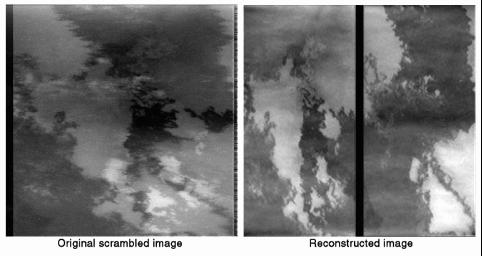This pair of images depicts the magic worked by JPL engineers to repair radiation damage to images taken by NASA's Galileo spacecraft camera during an October 10 close flyby of Jupiter's volcanic moon Io.
The majority of the Io images acquired by Galileo that day were taken in a camera mode in which 2x2 blocks of picture elements are supposed to be added together during readout of the image from the detector. Because the environment around Io has very high radiation, this mode was implemented to provide additional protection against corruption of the images due to radiation-induced noise. However, apparently due to accumulated radiation damage to the camera electronics, this readout mode did not function properly during the flyby. The effect was that the right and left sides of the images were added together during readout, rather than adjacent pairs of picture elements. This produced something akin to a double-exposed image.
Engineers figured out how the images had been garbled by carefully examining the images and the way the detector readout is commanded. Until recently, it was thought that repair of the images would be impossible. However, an innovative technique has just been developed at JPL for separating the two halves without introducing excessive errors. The scrambled raw data were unscrambled by a program developed using the LabVIEW software from National Instruments of Austin, TX. The image recovery results have been amazing. They allow for reliable analysis of the surface morphologies seen in the Io images.
The image shown here (left: -- original scrambled image; right -reconstructed image) covers a portion of the lava flows emanating from avolcanic center on Io named Zamama. The intricate, convoluted margins of the flows are characteristic of "pahoehoe" (smooth, ropy) lava flows seen on Earth, and provide information on how the lava erupted and advanced over the ground.
North is to the lower left of the picture and the Sun illuminates the surface from the lower left. The image, centered at 17.7 degrees latitude and 172.2 degrees longitude, covers an area approximately 16 by 16 kilometers (10 by 10 miles). The finest details that can be discerned in this picture are about 80 meters (260 feet) across. The image was taken on October 10, 1999 at a range of 1,800 kilometers (1,100 miles) by Galileo's onboard camera.
The Jet Propulsion Laboratory, Pasadena, CA, manages the Galileo mission for NASA's Office of Space Science, Washington, DC. JPL is a division of the California Institute of Technology in Pasadena. This image and other images and data received from Galileo are posted at http://solarsystem.nasa.gov/galileo/ Background information and educational context for the images can be found at http://galileo.jpl.nasa.gov/gallery/io.cfm.

 Planetary Data System
Planetary Data System












